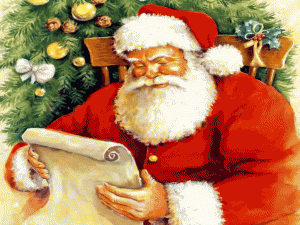christmas theme week : the true history of santa claus
Recently, my four-year-old niece asked ‘where does Santa come from?’ I instinctively answered, ‘from the North Pole’, and she seemed convinced. While I was relieved she had not asked the dreaded question – ‘is Santa real?’ – she had got me thinking about just how the legend of Santa developed. Surely the festive season was not always as cheesy and commercial as it is nowadays? I decided to satisfy my curiosity by doing a wee bit of research on the topic, all in the spirit of Christmas.
It all started with the Christian bishop St Nicholas. He lived in Myra (modern-day Turkey) in the 4th century CE. St Nicholas became renowned for giving to the poor, particularly young people. Legend has it he even restored the lives of three murdered boys. Byzantine portraits and icons of St Nicholas have parallels with Santa; an aged man with a grey beard wearing red or purple robes. It would take many centuries and several major image changes before the Santa as we know him as fully emerged.
Other mythological figures contributed to the modern persona of Santa. The Norse God Odin (known as Woden in Anglo-Saxon cultures) is often compared with St Nicholas. Nordic folk tales tell of Odin leading troops of hunters through the evening sky on his eight-legged horse Sleipnir. He is said to have visited the ‘good’ children at night. Odin would even leave behind presents for them if he was satisfied with the treats they had left out for him and Sleipnir – doesn’t all this sound familiar?
Coming back to St Nicholas, his generosity to the young became associated with the winter holiday period long after his death. By the 11th century, he had a cult following in Europe. The Dutch embraced St Nicolas as their Christmas patriarch, calling him, among other things, Sinterklass and Santa Klaus.
The image of the portly man dressed in red and sporting a flowing white beard comes from the Dutch Sinterklass/ Santa Klaus. He even wore a red hat (the pom-pom came later). This figure was, however, much more serious than the jolly Santa Claus we know today. It seems he was too busy discerning the naughty from the nice to show just a little warmth.
Fans of Santa owe a lot to the Dutch and the Germans. These cultures started the tradition of giving gifts to children on December 5th, the eve of St Nicholas’ feast day. This custom continues and, in Germany, is known as Christkindl. The English-speaking world uses the term Kris Kringle (aka Secret Santa) for the tradition of sharing gift giving amongst a group by having each individual purchase something for just one other person (with the members of the group not knowing for whom the others are buying gifts).
Speaking of the English, they have celebrated Father Christmas as a figure synonymous with the Christmas spirit since the 16th century. A Christian society, the English incorporated Father Christmas into Christmas celebrations on December 25th, rather than celebrating on the 5th. He was depicted in bright green (the colour of peasants) prior to the 20th century. Charles Dickens included a character closely resembling Father Christmas – the Ghost of Christmas Present – in his novella A Christmas Carol (1843). This and other literary references to Father Christmas cemented the folk figure’s place in English culture.
Doing what they do best, the Americans drew on traditions from around the world to craft Santa Claus, and claimed him as their own. The poem A Visit from St Nicholas was published anonymously by a New York newspaper in 1823. Famous for its opening line – ‘Twas the night before Christmas’ – it painted a picture of St Nicholas as the plump, bearded old man in red and white, and added in the sleigh and reindeer; it even gave them their names. On the subject of names, the Americans began using the name Santa Claus in place St Nicholas in the 1860s. As the 20th century rolled on, this American image of Santa Claus overtook that of his European predecessors in many Western countries. Children began sending their Christmas wish lists to the North Pole each year, as my niece recently has.
Researching this piece made me think back to what Santa meant for me when I was a child. I remember dutifully putting out the glass of milk and biscuits for Santa on Christmas Eve; carrots for his reindeer. And I am sure I saw Santa in the living room one year; in hindsight, I think it was my dad in costume.
I am still a loyal fan of Santa. Granted, I do not feel entirely comfortable with his patriarchal image (I am sure Mrs Claus is the brains behind the whole thing), nor do I think we should be encouraged to show love through material objects. I do, however, like to the notion of being rewarded for good deeds and that there are people who show kindness to the young. Most of all, I am partial to the belief that there is still a bit of magic in the world; surely it must be magic if he visits all those houses in just one night!


